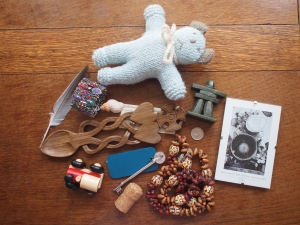This is a really simple yet effective writing lesson. There is nothing like some unusual objects to spark your students’ imagination!
Aim: For students to write a short story inspired by an object (and to have the opportunity to review question forms).
Level: A2+
Preparation: Before class you need to prepare a bag of unusual or interesting objects. The picture above is of objects I found in a quick look around my house that would be suitable to use. Good objects are keys, jewellery, old coins, ornaments (non-breakable!), etc – nothing too valuable or precious to you just in case they get damaged. You need at least one object per student, plus one to use as an example.
Task:
1. Ask a student to choose an object out of the bag (without looking!). Use this as the example object. Ask the student what the object is (depending on what it is this may be easy or may be a guessing game!) and for some words or phrases to describe it. Write up any interesting vocabulary that comes up.
2. Pass the bag around class and ask each student to choose an object (without looking in the bag).
3. Put the students into small groups and ask them to describe the objects. Note any interesting vocabulary on the board, and also any obvious words that aren’t mentioned. When they have finished discussing ask them which of the words on the board they think relate to which objects.
4. Write the following words on the board in a list going down: What, Who, Where, When, Why, How. Ask the students how they could complete questions about the objects that start with these words. You could do this as a whole class activity, in their groups or individually. You might get slightly different answers, but you will probably end up with something like this:
– What is the object?
– Who does it belong to?/ Who owns it?
– Where did they get it?
– When did they get it?
– Why do they have it?/Why is it important to them?
– How do they feel about it?/How did they get it?
(If problems come up with question formation this would be a good opportunity to review the structure, and you might also want to discuss why some of the questions are in the past, some in the present)
5. Ask the students to discuss these questions in their groups, and to use their imaginations! If any of them are struggling with ideas for their object you can allow them to swap with another student, or choose a different object if you have enough.
6. Finally, ask them to write a short story that features their object. They could focus on one or all of the questions they have discussed before (eg. a story about how the person got the object), or the story could be more about the person they imagined owning the object with the object only having a small role. Alternatively, you could ask your class to write a story that features all of the objects in their group (more challenging but potentially more interesting!). Another idea would be a collaborative story where the first person writes the start of a story featuring their object, someone else writes the next part and has to include their object, etc. This is best set as a homework task using a wiki or blog. As a low tech option, one person could write it one night for homework, then pass to the next person the next day, etc and you could follow-up with editing all together in a future class (does mean you need reliable students though!)
7. When the stories are finished, as always, it is nice to display them in class, publish on a class blog or wiki, or simply get them to read them to their groups.

Pingback: Pet peeves and new #ELT blogs | ELT Rants, Reviews, and Reflections